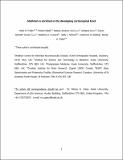Stathmin is enriched in the developing corticospinal tract
Abstract
Understanding the intra- and extracellular proteins involved in the development of the corticospinal tract (CST) may offer insights into how the pathway could be regenerated following traumatic spinal cord injury. Currently, however, little is known about the proteome of the developing corticospinal system. The present study, therefore, has used quantitative proteomics and bioinformatics to detail the protein profile of the rat CST during its formation in the spinal cord. This analysis identified increased expression of 65 proteins during the early ingrowth of corticospinal axons into the spinal cord, and 36 proteins at the period of heightened CST growth. A majority of these proteins were involved in cellular assembly and organisation, with annotations being most highly associated with cytoskeletal organisation, microtubule dynamics, neurite outgrowth, and the formation, polymerisation and quantity of microtubules. In addition, 22 proteins were more highly expressed within the developing CST in comparison to other developing white matter tracts of the spinal cord of age-matched animals. Of these differentially expressed proteins, only one, stathmin 1 (a protein known to be involved in microtubule dynamics), was both highly enriched in the developing CST and relatively sparse in other developing descending and ascending spinal tracts. Immunohistochemical analyses of the developing rat spinal cord and fetal human brain stem confirmed the enriched pattern of stathmin expression along the developing CST, and in vitro growth assays of rat corticospinal neurons showed a reduced length of neurite processes in response to pharmacological perturbation of stathmin activity. Combined, these findings suggest that stathmin activity may modulate axonal growth during development of the corticospinal projection, and reinforces the notion that microtubule dynamics could play an important role in the generation and regeneration of the CST.
Citation
Fuller , H , Slade , R , Jovanov-Milošević , N , Babić , M , Sedmak , G , Šimić , G , Fuszard , M A , Shirran , S L , Botting , C H & Gates , M 2015 , ' Stathmin is enriched in the developing corticospinal tract ' , Molecular and Cellular Neuroscience , vol. In press . https://doi.org/10.1016/j.mcn.2015.09.003
Publication
Molecular and Cellular Neuroscience
Status
Peer reviewed
ISSN
1044-7431Type
Journal article
Description
This study was generously supported by a grant (20114975) from The Henry Smith Charity. The authors acknowledge the Wellcome Trust for funding the BSRC Mass Spectrometry and Proteomics Facility at the University of St Andrews and in particular for grant 094476/Z/10/Z to CHB which funded the mass spectrometer this work was carried out on and supported MAF. The work with human tissue by GSi, NJ-M, GSe and MB was supported by the Croatian Science Foundation Grant No. 09/16.Collections
Items in the St Andrews Research Repository are protected by copyright, with all rights reserved, unless otherwise indicated.

